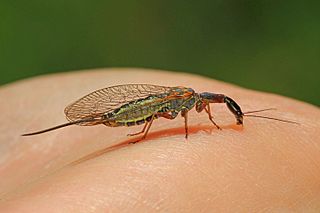
Snakeflies are a group of predatory insects comprising the order Raphidioptera with two extant families: Raphidiidae and Inocelliidae, consisting of roughly 260 species. In the past, the group had a much wider distribution than it does now; snakeflies are found in temperate regions worldwide but are absent from the tropics and the Southern Hemisphere. Recognisable representatives of the group first appeared during the Early Jurassic. They are a relict group, having reached their apex of diversity during the Cretaceous before undergoing substantial decline.
Paleontology or palaeontology is the study of prehistoric life forms on Earth through the examination of plant and animal fossils. This includes the study of body fossils, tracks (ichnites), burrows, cast-off parts, fossilised feces (coprolites), palynomorphs and chemical residues. Because humans have encountered fossils for millennia, paleontology has a long history both before and after becoming formalized as a science. This article records significant discoveries and events related to paleontology that occurred or were published in the year 1909.
Paleontology or palaeontology is the study of prehistoric life forms on Earth through the examination of plant and animal fossils. This includes the study of body fossils, tracks (ichnites), burrows, cast-off parts, fossilised feces (coprolites), palynomorphs and chemical residues. Because humans have encountered fossils for millennia, paleontology has a long history both before and after becoming formalized as a science. This article records significant discoveries and events related to paleontology that occurred or were published in the year 1914.
Paleontology or palaeontology is the study of prehistoric life forms on Earth through the examination of plant and animal fossils. This includes the study of body fossils, tracks (ichnites), burrows, cast-off parts, fossilised feces (coprolites), palynomorphs and chemical residues. Because humans have encountered fossils for millennia, paleontology has a long history both before and after becoming formalized as a science. This article records significant discoveries and events related to paleontology that occurred or were published in the year 1936.

Inocelliidae is a small family of snakeflies containing 8 genera of which one is known only from fossils. They are commonly known as inocelliid snakeflies. The largest known species is Fibla carpenteri known from fossils found in baltic amber.

Nanoraphidia is an extinct genus of snakefly in the family Mesoraphidiidae containing the species Nanoraphidia electroburmica and Nanoraphidia lithographica.
Fibla carpenteri is an extinct species of snakefly in the Inocelliidae genus Fibla. F. carpenteri is named in honor of the paleoentomologist Dr Frank Carpenter, for his vast knowledge and interest in Raphidioptera.
Electrinocellia is an extinct monotypic genus of snakefly in the family Inocelliidae containing the single species Electrinocellia peculiaris and known from Eocene aged Baltic amber.
Ororaphidia is an extinct genus of snakefly containing two species: the type species Ororaphidia megalocephala and Ororaphidia bifurcata.

Styporaphidia is a genus of snakefly, belonging to the extinct family Mesoraphidiidae, containing up to three species, the type species Styporaphidia magia, Styporaphidia willmanni and tentatively Styporaphidia? hispanica. The genus was named from the Greek stypos meaning "stem" or "stump" and Raphidia, the type genus for, and most often used as, a stem for generic names in the order Raphidioptera. The species name of S. magia is from the Greek word mageia meaning "magic" while the species name for S.? hispanica is from the Latin Hispania meaning "Spain" in reference to the type locality of the species.

Archiinocellia is an extinct genus of snakefly in the family Raphidiidae known from Eocene fossils found in western North America. The genus contains two species, the older Archiinocellia oligoneura and the younger Archiinocellia protomaculata. The type species is of Ypresian age and from the Horsefly Shales of British Columbia, while the younger species from the Lutetian Green River Formation in Colorado. Archiinocellia protomaculata was first described as Agulla protomaculata, and later moved to Archiinocellia.

Agulla is a genus of modern snakeflies in the family Raphidiidae.
Agulla mineralensis is an extinct species of snakefly in the raphidiid genus Agulla. The species is solely known from the Middle Miocene, late Bartovian stage, Pacific Union Site in the Stewart Valley Group, Mineral County, Nevada.
Halictus? savenyei is an extinct species of sweat bee possibly in the halictid genus Halictus. The species is solely known from the Early Eocene, Ypresian stage, Coldwater Beds, part of the Princeton Group, in the Quilchena area, Nicola Country, British Columbia, Canada.

Necroraphidia is an extinct genus of snakefly in the family Mesoraphidiidae. The genus is solely known from Early Cretaceous, Albian age, fossil amber found in Spain. Currently the genus comprises a single species, Necroraphidia arcuata.

Alavaraphidia is an extinct genus of snakefly in the family Mesoraphidiidae. The genus is solely known from an Early Cretaceous, Albian age, fossil amber found in Spain. Currently, the genus comprises a single species, Alavaraphidia imperterrita.

Cantabroraphidia is an extinct genus of snakefly in the family Mesoraphidiidae. The genus is solely known from fossil amber found in Cantabria, northern Spain, dating to the Albian age of the Early Cretaceous Period. Currently the genus comprises a single species Cantabroraphidia marcanoi.
Lebanoraphidia is an extinct genus of snakefly in the family Mesoraphidiidae. The genus is solely known from Cretaceous, Upper Neocomian, fossil amber found in Lebanon. Currently the genus is composed of a single species Lebanoraphidia nana.
Iberoraphidia is an extinct genus of snakefly in the family Mesoraphidiidae. The genus is solely known from a Cretaceous, Lower Barremian, fossil found in Spain. Currently the genus is composed of a single species, Iberoraphidia dividua.

Raphidiidae is a family of snakeflies in the order Raphidioptera.










